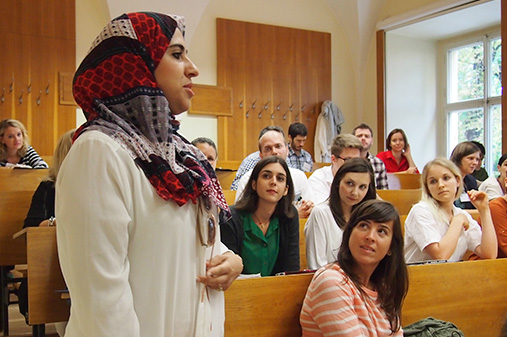Junior Awardee: Mitochondrial and oligodendrocytic processes in MSA | Congress 2025
Dr. Eduardo De Pablo Fernandez: Hello everyone, and welcome to a new episode of the MDS Podcast, the official podcast of the International Parkinson and Movement Disorder Society. My name is Eduardo De Pablo Fernandez from the Center for Preventive Neurology at Queen Mary University in London. I have the pleasure of hosting today, one of the two individuals receiving the Junior Award, which acknowledges the work of up and coming specialist age 40 or younger, who submitted their work to the Congress abstracts.
Her name is Lydia Chougar. She's currently based at the Montreal Neurological Institute of the McMill University in Montreal, Canada. But the work that she's presenting at the Congress is a collaboration between that institution and the Institut du Cerveau University in Paris, France.
Lydia, thank you very much for [00:01:00] joining us and congratulations for your award. So before we discuss a bit your project I would like you to make a brief introduction about yourself. What is your background and what is your research interest?
Dr. Lydia Chougar: Good morning, Eduardo. Thanks a lot for the invitation. So indeed I'm a neuroradiologist trained at Pitié-Salpêtrière Hospital in Paris. After my medical studies, I completed a research master degree in biomedical imaging. Afterwards, I decided to pursue a PhD in neuroscience on the topic of neuroimaging in atypical Parkinsonian syndromes.
So the overall aim of my research is to improve the early differential diagnosis of Parkinsonian syndromes using neuroimaging and also using neuroimaging to better understand the pathophysiology of the diseases. So I'm using a full range of multimodal MRI tools in combination with the machine learning [00:02:00] algorithms to improve the diagnosis, understand the pathophysiology.
So this is the frame of my research.
Dr. Eduardo De Pablo Fernandez: That's very interesting. And one good example of your research is the work that you're presenting at the Congress. So it is titled, atrophy in multiple system atrophy relates to the mitochondrial and oligodendrocytic processes. In this study, you use more routine MRI sequences to combine that with other techniques that can give you a bit of an understanding about the underlying pathogenic processes that relate to those structural abnormalities that we can detect on the MRI. And you have studied a total of 65 patients with MSA and 181 healthy controls. Can you tell us a bit about the aim of the study and the population of the study?
Dr. Lydia Chougar: Yeah, as we all know, multiple system atrophy is neurodegenerative disease and alpha synucleinopathy that targets primarily oligodendrocytes. [00:03:00] However, the pathophysiology of the disease is still poorly understood. And we can use neuroimaging to better understand these underlying pathological mechanisms.
One way to achieve that is to use techniques where we combine neuroimaging biomarkers with data can be transcriptomic, it can be PET-derived data, data that is derived from data sets of healthy controls. And so by combining these two sets of data imaging from the population of patients and this transcriptomic and PET derived data from healthy controls, we can better understand what are the underlying biological mechanisms.
So these two techniques. So on one hand there is the imaging transcriptomics that is using this normative transcriptomic data, especially from the Allen Human Brain Atlas and can explain later, what is this atlas? On the other hand, these PET derived maps. So by [00:04:00] using these two techniques, we can dive into the pathophysiology.
Dr. Eduardo De Pablo Fernandez: Yeah, that's very interesting. And obviously it's very useful to this large data sets publicly available. In the first part of your study, you used your MRI data to see the association with transcriptomics, so what is called imaging transcriptomics. Can you tell us a bit more how you combine these two techniques and what they tell us about in the study population?
Dr. Lydia Chougar: Yeah. The first step of this analysis to derive measures of atrophy. It can be like any MRI measure gives an idea on the pattern of abnormalities, of alterations in the brain of these patients. So first, I derive these measures of atrophy using some specific imaging softwares that segment the brain images.
And the volume from these images, from that I derive a pattern of brain atrophy that is specific. So in MSA I showed, and this is well known that there is a atrophy that targets the brain regions. [00:05:00] So, especially pons and cerebellum.
And on the other hand, basal ganglia, especially the putamen. So these are the core regions that are altered in the MSA. And in the second step of this analysis, I used transcriptomic data derived from the Allen Human Brain Atlas. So the Allen Human Brain Atlas is a transcriptomic atlas that was built on t ranscriptomic data. So gene expression data over throughout the whole brain, derived from six postmortem brains of healthy controls, six healthy controls. And so using these types of data sets, so on the other hand the atrophy measures from my MSA population, on the other hand, the transcriptomic data from this Allen Human Brain Atlas.
So I had these two matrices, and what I did is that I combined, related these two matrices of MRI data, transcriptomic data using a statistical approach that we called the partial list square regression analysis. So using this partial list square analysis on these two matrices, I actually show how [00:06:00] the genes in this Allen Human Brain Atlas, how these genes relates to the atrophy pattern that is seen in my patients. So I derived gene expression components that are associated with my specific pattern of atrophy in MSA.
Dr. Eduardo De Pablo Fernandez: It's I guess it's reassuring that the findings that you got on the MRI in your study are consistent with what we know in the literature and sort of match what we find in the pathology. And when you correlated that with the transcriptomic data, what did your results show?
Dr. Lydia Chougar: Yeah, so using this type of correlation between these two data sets. So I derived gene expression data showing which sets of genes are related to my atrophy. And then once I identified these gene expression components, I was able to do what we call a gene set enrichment analysis.
This gene set enrichment analysis is actually a method that tells you biological functions are related to groups of genes. So you can [00:07:00] access this information using online platforms. So the platform I use is called WebGestalt, but there are other platforms that can use, so this is, yeah, in the context of gene set enrichment analysis.
So how can you infer on which biological mechanisms are related to sets of genes? And so using this approach, I was able to see atrophic regions shown in MSA. There is actually another expression of genes that are related to mitochondrial function and on the other hand, oligodendritic processes.
So these are key findings of my study, over expressions of genes related to mitochondria and oligodendrocytes in atrophic region.
Dr. Eduardo De Pablo Fernandez: That's very interesting and we will discuss a bit how to interpret these results a bit later. Let's talk about the second part of the study where you try to associate the atrophy found on MRI imaging, PET receptor density maps that again, are publicly [00:08:00] available and they can be used freely.
Can you tell us a bit how you use these two data sets and what results your studies show?
Dr. Lydia Chougar: Yeah, so the idea is the same for emerging transcriptomics. Ideally, we would like to have, transcriptomic PET data from our population of MSA, but this is very hard to achieve, in general because these patients are very rare. It's very hard to collect data.
We do need a lot of data. So to overcome this limitations, this lack of data that you can extract from your population of patients, what you will do is instead using data from healthy control. So this is the same idea for imaging transcriptomic and this PET annotation approach. So in this pet annotation approach, what I did again is trying to find the association between the pattern of atrophy and MSA patients and this receptor density maps derived from PET data of healthy controls.
So indeed these [00:09:00] receptor maps are publicly available. So that's a huge work actually that has been done by a team based at the Montreal Neurological Institute. So they gathered PET data from a lot of different centers across the world. They gathered a thousand data maps from different healthy controls.
And so, yeah, coming back to my study, the idea is to investigate the correlations between the pattern of atrophy in my patients receptor density maps. And so to see which in my atrophic regions which receptors are associated. So it can be positive or negative correlation.
So it informs i s there a deficit or another expression of certain specific receptors in the atrophic region.
Dr. Eduardo De Pablo Fernandez: Excellent. So let let's get a bit more deeper on the on the results on how to make some conclusions about this. So the first point that you raised before is that genes associated with mitochondrial function showed some association with your atrophic areas on MRI.[00:10:00]
So mitochondrial function is one of the pathways that is impaired in neurogenerative diseases. So, do you think this is just like a common pathway in many of them, or do you think your findings are specific to MSA?
Dr. Lydia Chougar: Yeah. So this is true that mitochondrial dysfunction is, it's a common pathway that is seen in many neurodegenerative disorders. This has been shown in Alzheimer's disease, in Parkinson's disease. Probably other diseases as well. What is specific to my study is that the, the pattern of atrophy is different.
So actually I found this overexpression of genes related to mitochondrial functions relative to this pattern of atrophy. So to test actually the specificity of these findings, I repeated the analysis in a sample of PD patients. And so what I showed is that when I use the same brain regions, so when I focus on the deep brain regions, cerebellum, brainstem, basal ganglia, I do find this [00:11:00] overexpression of mitochondrial genes in MSA, but not in PD.
So what it shows is that there is this overexpression that is specifically linked to this pattern of atrophy in MSA.
Dr. Eduardo De Pablo Fernandez: That is very, very interesting. The other point you discussed before briefly is the role of oligodendrocytes in multiple system atrophy. So we know from pathology studies that the main, or the hallmark inclusions affected the cytoplasm of these cells. And obviously there is a growing evidence suggesting that they have a key role in the pathogenesis of multiple system atrophy.
How do you interpret your studies in this context? And also, I guess when you use healthy control data, one may wonder whether these abnormalities that you see are part of the pathogenic process or, protective response from this cells to progression of the disease.
How do you interpret this results in the context of the literature?
Dr. Lydia Chougar: Yeah, so going back to the first question, the [00:12:00] oligodendrocytes, so I find it very interesting only relying on a simple measure of brain atrophy, which is very easy to derive from brain images. So only relying on that. In combination with this normative transcriptomic data, we were able to show actually that this atrophy pattern that we saw in MRI reflects like your true underlying biological mechanism.
And it shows that the target is oligodendrocytes. So it shows actually that MRI imaging are like biologically meaningful. It gives a value to these markers so I agree that's knowledge that we already have. We know that there is a mitochondrial dysfunction in neurodegenerative diseases.
This is the case in MSA as well. We know that this targets oligodendrocytes, but what is new in the study is that we show that these markers have a biological significance. And this is very interesting in this context of developing biomarkers to monitor [00:13:00] the disease progression, to monitor the effects of treatments.
I think that's very important. Like it gives a biological validation to these markers.
Dr. Eduardo De Pablo Fernandez: I think it's very interesting to see the correlation between the structural abnormalities and the underlying biological processes. Thank you very much for this discussion and I would encourage all the listeners to attend your presentation at the Congress. I dunno if you would like to add anything or, what are your plans for the future?
What is your future research about?
Dr. Lydia Chougar: Yeah, so the future of my research, so I'd like to pursue in this direction. So, keep expanding my research on Parkinsonian disorders. So currently I'm focusing on ultra high field strength MRI. So, these MRI machines use like a very high magnetic field, seven Teslas.
So I think that we can really benefit from this technology. It gives a much better image quality, higher spatial resolution, higher signal to noise ratio. [00:14:00] So I believe that we can really improve the level of our research using this technology. So this is my current focus. Another area that I'm interested in, I'd like to develop in the future is the field of spinal cord imaging Parkinsonian disorders.
I believe it's a n understudied field, but it's very important, especially in the context of Parkinson's disease. 'cause the focus has been put on the brain, but there is a lot of things happening below at the spinal cord level. So yeah, I think that's something to develop.
Dr. Eduardo De Pablo Fernandez: That's very interesting and something to look forward to. I had on the podcast, Dr. Lydia Chougar, and we discussed her work atrophy in multiple system atrophy relates to mitochondrial and oligodendrocytic processes. Thank you again, and congratulations your award. And thank you everyone for listening. Bye bye for now. [00:15:00]

Lydia Chougar, MD, PhD
McGill University
Montreal, Canada









